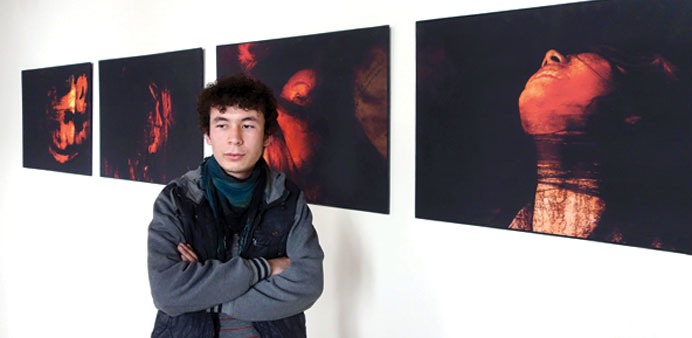Naseer Fedaee Turkmani in front of some of his mixed-media art, which contains photography and painting.
By Subel Bhandari
"Only have sad stories to tell,” a 23-year-old Afghan mixed-media artist, Naseer Fedaee Turkmani, says in Kabul. His works, combining photography and painting, hang in an exhibition of entries for the Afghan Contemporary Art Prize, an annual competition to encourage Afghan artists to venture into uncharted territory in modern art.
Turkmani fled his home with his family at the age of 7 in 1997, the year after the Taliban took over Kabul. “I lived my entire teenage years as a refugee in the Pakistani city of Quetta,” he said at the exhibition, held in the renovated Queen’s Palace built by the Mughal emperor Babur in the 16th century. “I saw so many sad things. Now, I cannot express happiness through my art.”
Most of Turkmani’s works feature people’s faces. He said each Afghan face shows “the hardship people face.”
“Life is very difficult here. Many of my art works are against the indifference of the government,” he said.
In one provocative photo installation, Turkmani shows a woman’s face in a dark red hue. It is covered, defaced and tortured.
He says it is to show the problems Afghan women face daily, ranging from domestic abuse to forced and under-age marriages, giving women away to settle debts, and more.
Most of the work in the contemporary art exhibition is provocative, showing the plight of daily life in Afghanistan.
One shows skeletons walking through an Afghan town. Another shows a Taliban mullah with a guitar.
A video installation shows a 2D animation of random footprints and dollar bills which attach themselves to different Afghan hats. The result is bloody battles fought with bullets and bombs.
The Prize programme begins with a two-week-long workshop where 10 young Afghan artists were chosen from more than 100 applicants to learn from visiting international artists and continues with the exhibition.
The young artists exhibit finished work for the competition in various mediums, including paint, photography, video, installation and mixed media.
Francesca Recchia, the director of the event, said the art of the young artists “opens spaces of hope and imagination for the future of the country.”
“War, violence and political instability have had a dramatic impact on the growth and development of cultural production in Afghanistan and made the arts a low priority on the political agenda,” Recchia said.
“In recent years, Afghanistan has witnessed the blossoming of an important cultural and artistic revival,” the Kabul-based Italian academic said.
The art prize was established in 2008 by the Turquoise Mountain Trust, a British-based charity that works in art and cultural preservation.
Tommy Wide, the country director for Turquoise Mountain, said the idea was to support Afghan artists and artisans and to foster a lively and stimulating local arts scene.
“We want to show a different side with this exhibition. There are incredibly talented youth in the contemporary art scene in Afghanistan. They also need support to flourish creatively.”
Contemporary and modern art is still seen with a certain disdain by many Afghans as a Western import. “Afghanistan has a rich history of traditional art and culture,” said Mir Farukh Hossaini, a conservative imam in Kabul.
“This Western-style modern art ... should be discouraged because it only promotes Western ideas and values. It tends to corrupt young minds away from Islam.”
Traditional art has been reviving too. But for artists, both traditional and modern, it is hard to survive on art income alone.
Turkmani takes wedding and fashion photos to earn a living.
He has also been attacked when taking photographs for his art projects. “I was working on documenting people’s lives. And quite a few times, I have been attacked by mobs, who destroyed my camera and beat me up,” he said. “People here do not understand art and artists.”
Masooda Noori, an 18-year-old student at Kabul University, was one of the two top prize winners. “It feels great. I was introduced to modern art only recently,” Noori said. “I like to make art out of the problems which we face.”
Her installation art on the country’s election won the best prize. She show wooden beehives as ballot boxes, and a video of people, which she said was depicting the honey bees at the hives. “I don’t really believe that the election does the country any good,” she said, holding her certificate awarding her $1,150 in prize money.
“Every time after each election, I hear people saying how their lives did not change. Instead, they got worse.”
Afghanistan is scheduled to hold presidential elections next year. “I hope 2014 will bring change. But I do not believe it will,” she admitted. — DPA



